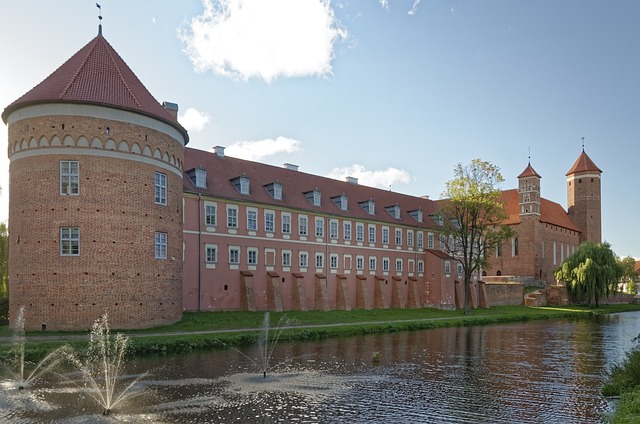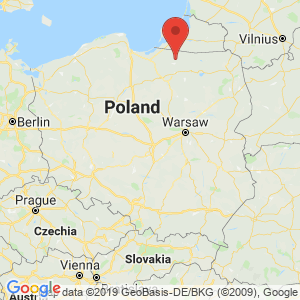Lidzbark Warmiński

The diocese of Lidzbark. In the foreground the southern front, as seen from the southeast. – Picture of 680451 from Pixabay
Distance
Population
16.826 (2016)
Location and history
Lidzbark Warmiński is located in northeastern Poland, in the countryside / district of Warmia (Warmien), which is today part of Warmian-Mazury County. Through the city itself, the river Łyna runs. A tributary, Symsarna, has its outlet in Łyna near the city center.
City name: The last part of the name is naturally due to the town being in Warmia. The addition is also given to avoid confusion with the name of the town of Lidzbark Welski (southwest). The first part, Lidzbark, goes back to the Prussian name: Lecbarg. During the time when the city was German, it had the name Heilsberg.
The Prussians: The Prussians were a people who inhabited the northeastern part of present-day Poland. There were often bloody battles between Prussian and West Slavic tribes. These struggles continued into the Middle Ages, following the formation of the Polish state. The Polish prince, Konrad Mazowiecki, in 1226 made an agreement with the German Crusader Order for the help of Christians and conquer the Prussian territories. The Knights' efforts were effective – and bloody. The Prussians were defeated, and they became Christian – with or against their will. Knights from Poland also participated. Over time, the Prussians became predominantly Germanic. The Crusaders created their own state of order. Much later in this area was created the province of East Prussia, part of the Prussian state. The word Prussia, moreover, is derived from the name of the original inhabitants: the Prussians.
The Prussian language, now extinct, was (and is) a Baltic language, that is, in a family of Lithuanian and Latvian, and is therefore not directly related to Slavic languages, such as Polish.
The Prussian settlement of Lecbarg was conquered in 1240 by the Crusaders. From this year comes the first mention of the city. Already a year later, the order had erected a tree-built castle on the site. But in 1242, a rebellion by the Prussians erupted against the Crusaders. Below, Lecbarg was captured by the Prussians and destroyed. However, the Crusaders won the town back in 1243. In 1251 the castle was handed over to the first bishop of the Warmian diocese, Anzelm, who was a member of the Crusader Order. Lidzbark thus went from hand to hand several times; in 1261 the city was conquered by the Prussians; in 1274 it was recaptured by the Crusaders. The third Welsh bishop, Eberhard of Nysa in Silesia, granted the city market town rights in 1308. Precisely because the bishop was from Silesia, he caused many people, both Poles and Germans, to leave from Silesia to settle in Lidzbark.
The new Episcopal castle was built on the land between the rivers Łyna and Symsarna, just before the end of Symsarna in nasyna. The town of Lidzbark was built on the western bank of the Lyna River. Already in the 14th century. a town hall, church and hospital were erected. At the end of the 14th century. one began to build a city wall with brick towers and gates. Around 1390, the first water supply was built in the city. Many actions at that time were due to Bishop Jan z Miśni (ty.: Johannes von Meissen) who in 1350 chose Lidzbark as the seat of the warmish diocese (it was formerly Orneta). Also in 1350, Bishop Jan began erecting a foundation-walled castle that would house the entire diocese's administration, enacting laws and exercising the local judiciary (holding of litigation). Attached was also a school, just as diplomatic and cultural gatherings took place here.
In 1410, Bishop Heinrich von Vogelsang sent a number of local soldiers to support the Crusaders in the Battle of Grunwald. However, they – like the crusaders themselves and other forces who supported them – were overcome or hunted. After that, Lidzbark had to recognize the Polish king as overlord. Shortly after, the Order of the Crusader Grand Master Heinrich von Plauen chose the castle in Lidzbark as his headquarters. In 1414 Lidzbark was partially burned down by the Polish army which had besieged the city. In the middle of the 17th century. Lidzbark had to defend himself against the attack of the Swedish army and between 1703 and 1709 the city was occupied by the Swedes. It was in Lidzbark it was decided that Stanisław Leszczynski should be king of Poland – supported by the Swedes. 1767-1795, the poet Ignacy Krasicki was bishop of Warmia.
After Poland's first division in 1772, Lidzbark was incorporated into the Kingdom of Prussia. The bishop lost booklets his power. The land was divided into districts, and on the castle the Prussian army created a garrison. After Poland's second split, Ignacy Krasicki left Warmia and later the bishop's seat was moved to Olsztyn, whereby Lidzbark began to lose his former dominant position. In June 1807, a large battle at Lidzbark was fought between Napoleon's French army on the one hand and Russian and Prussian forces on the other. Three city gates: the church gate, the Mill Gate and the Borg Gate, were demolished as it was believed that they hampered the traffic in the city.
During World War I, the city was briefly occupied by the Russian army.
At the end of World War II, Lidzbark was occupied by Soviet forces. After the fighting in that regard, almost 80% of the city was destroyed.
In 1945, Lidzbark returned to Poland. In the following years the population increased, among other things. through migrants from central Poland and from the former eastern regions. In 1958, of course, mainly for economic reasons, it was decided not to rebuild much of the ruined houses in the old town, which is why in the following years a number of concrete buildings were erected in the inner city.
Tourist attractions
Selected attractions:
Borgen
The impressive diocese of Lidzbark stands on the river Symsarna’s outlet in Łyna. It is still surrounded by a water-filled moat. The facility consists of the main fortress and the suburb to the south. which is separated from the main castle by a dry moat. Only the northern precinct is not preserved; here stood the mill of the castle. The castle is built of bricks over a square floor plan with a lateral length of 48.5 m. In the northeast corner stands the impressive tower, which is 14 storeys high. The tower, which has numerous slots in the lower part, is square at the bottom, while the upper part is octagonal. On the other corner of the castle, small decorative, square towers have been erected. The inner courtyard is surrounded by archways on two floors. These are some of the few archways in Poland that have been completely preserved without architectural changes. The building is reminiscent of a Crusader fortress and not just from the outside. On the first floor are chapels, the small and large dining room, the meeting room, the auditorium and the bishop's apartment. Here are some interesting exhibitions dedicated to the Warminian bishop and especially Ignacy Krasicki. On the ground floor once worked the kitchen, bakery, storage room, brewery and school. The top two floors contained cereal storage and also had defensive purposes. Here were watchman times. Now there is a gallery of modern painting as well as an exhibition with Russian icons. There were also 2 underground floors on the castle. Here you will find the former armory, which is accessible to tourists. In front of the main gate to the main castle is the remains of a palace built in the 17th century. In the foreground is seen the renovated palace building erected by Bishop Grabowski. This building today houses a library. Outside, a solid tower is preserved. The current entrance to the entire facility is at the southwest corner building. Previously, the main entrance was located to the northwest. A person entering the castle had to walk along the western wing of the castle and only after passing 5 fortified gates was he able to enter the main castle – as today from the south side.
Peter and Pauls Church
from the 2nd half of the 14th century. with a huge, 70 meter high tower.
The High Gate
In the city center stands the High Gate (Wysoka Brama) built in 1466-1478. The building is intersected by a pointed arch. Originally it was an advanced gatehouse, designed for defense purposes and connected to the actual gate of the city wall via a 20 m long, walled connecting corridor.
Bymuren
Remains of the quite high city wall.
In the years 1767-1795, the author was Ignacy Krasicki bishop of Lidzbark.
Surrounding Area
- River Łyna
- Olsztyn-seascape
Other Internet sites and sources
Translated into English by Google Translate. Spangshus.dk accept no liability for any errors or omissions in translation.
Map

Rating
Search
Most used tags
churches (205) Castles (86) Monasteries (79) Town walls (74) Lakes (71) Town halls (67) Rivers (65) Castles1 (62) Mansions (55) Museums (51) Regional museums (38) Town gates (36) Abbey churches (35) Castle ruins (30) Cathedrals (26) Forests (25) Health resorts (24) Mounds (23) Water sports (23) National parks (22)Click for all tags
Denne side er også tilgængelig på dansk. This page and contents is (c) Copyright 2018- www.spangshus.dk. Based on Inviator software by ISCA Software